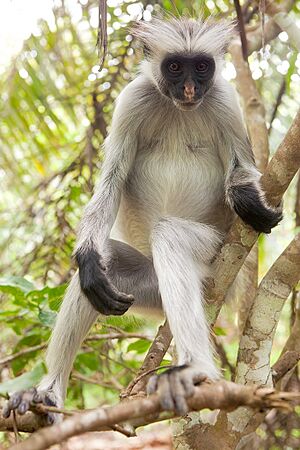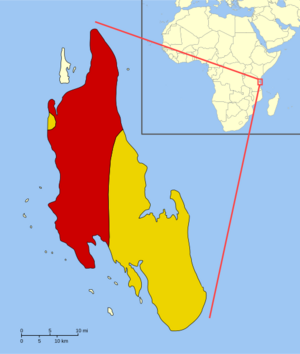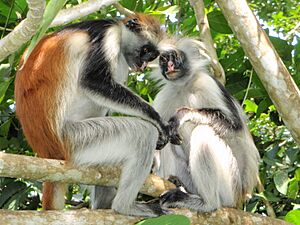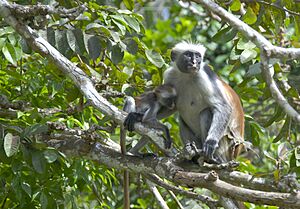Zanzibar red colobus facts for kids
Quick facts for kids Zanzibar red colobus |
|
|---|---|
 |
|
| Adult at Jozani Forest | |
| Conservation status | |
| Scientific classification | |
 |
|
| geographic range extant (resident) extinct |
The Zanzibar red colobus (Piliocolobus kirkii) is a type of red colobus monkey. It lives only on Unguja, the main island of the Zanzibar Archipelago, near Tanzania. It is also called Kirk's red colobus after Sir John Kirk. He was a British official in Zanzibar who first told scientists about this monkey.
Today, the Zanzibar red colobus is an endangered species. This means there are not many left, and they are at risk of disappearing forever. In the 1990s, it became a special symbol for protecting nature in Zanzibar. The number of these monkeys is still going down. People who work to protect animals are trying to help the local government create a good plan to save them and their homes. One big challenge is that these monkeys only live on this small group of islands.
Contents
How the Zanzibar Red Colobus Evolved
Scientists believe the Zanzibar red colobus became separated on the island when sea levels rose. This happened a very long time ago, near the end of the Pleistocene Ice Age. This separation caused them to become a unique species.
By looking at their skulls, scientists found that the Zanzibar red colobus is different from other red colobus monkeys on the mainland. Their skulls are smaller. This fits with something called Foster's rule, or the island rule. This rule says that large animals on islands often become smaller over time. This happens because there might be less food or space.
Scientists think the Zanzibar red colobus became its own species about 600,000 years ago. It is most closely related to the Udzungwa red colobus from mainland Tanzania. The monkey's scientific name has changed a few times. It used to be in the Colobus group, then Procolobus, and now Piliocolobus.
The common name, Kirk's red colobus, honors Sir John Kirk. He was a British official in Zanzibar who first brought this monkey to the attention of animal scientists.
Physical Description of the Monkey
This monkey has a coat that can be dark red or black. It has a black stripe along its shoulders and arms. Its belly is pale. Its black face has long, white hair around it. It also has a special pink mark on its lips and nose.
The Zanzibar red colobus has a long tail. It uses its tail only for balance, not for grabbing things like some other monkeys do. Male and female monkeys look very similar in size and color. Usually, there are more females than males in a group. These monkeys have a small head and a round body. Males can weigh over 12 kilograms (about 26 pounds), and females can weigh over 10 kilograms (about 22 pounds). Adult monkeys can tell each other apart by their unique faces.
The word "colobus" comes from a Greek word meaning "he cut short." This is because these monkeys have very small thumbs, or sometimes no thumbs at all. To help them climb, they have four long fingers that form a strong hook. This lets them easily grab branches.
Local people on the island call the Zanzibar red colobus kima punju. This means "poison monkey" in Swahili. They call it this because it has a strong smell, different from other monkeys. Because of this, some people used to think the monkey was bad for trees it ate from.
Where the Zanzibar Red Colobus Lives
The Zanzibar red colobus lives in three forests on the Zanzibar islands. It can live in many different places, but it mostly stays in trees. It likes drier areas more than wet ones. Its homes include thick coastal bushes and scrublands. It can also be found in farm areas and in mangrove swamps. Mangrove swamps are good because they provide food all year. When the monkeys are in farm areas, they are more used to people and come closer to the ground.
There are only about 1,600 to 3,000 of these monkeys left. About half of them live outside protected areas. The biggest and most important protected home for the monkey is Jozani National Park. This park has 25 square kilometers (about 9.6 square miles) of land for them. Many groups of monkeys have been found living in shambas (Swahili for "farmland") near the park. Living outside the protected park makes these monkey groups more endangered.
Monkey Behavior
Groups of Zanzibar red colobus usually have up to four adult males and many adult females. There are often twice as many females as males. Young monkeys of different ages are also part of the group. A group can have 30 to 50 monkeys. These monkeys are very social. You can often see them playing and grooming each other when they are resting between meals. Unlike females, males in a group stay very close. They work together to defend their group and even groom each other.
Feeding Habits
Eating is also a group activity. They start eating in the morning and are most active when it's cooler. Loud calls from males tell the group it's time to move to another tree to eat. This monkey mainly eats leaves. On average, half of the leaves they eat are young ones. They also eat leaf shoots, seeds, flowers, and unripe fruit. Sometimes, they eat bark, dead wood, and even soil.
It is one of the few monkey species that does not eat ripe fruits. It has a special stomach with four parts that help it break down plant material. However, it cannot digest the sugars in ripe fruits. Because the monkey eats young leaves, which can have natural toxins, it sometimes eats charcoal. Scientists think the charcoal helps them digest these toxins. This habit of eating charcoal is likely learned from their mothers. Monkeys are more likely to eat charcoal if they live in areas with trees that have a lot of these toxins.
Some groups of monkeys live in mangroves and eat mangrove plants. These plants have a lot of salt. So, these monkeys have learned to drink water directly from holes in trees or by licking water off leaves. This shows how smart and adaptable they are to their environment.
During the dry season, one of their main foods, the Indian almond tree, loses its leaves. This can make the monkeys go outside park areas to find food. This puts these already endangered monkeys at even greater risk.
Reproduction and Life Cycle
Male monkeys usually become old enough to have babies at about 3 to 3.5 years old. Females are ready at about two years old.
Colobus monkeys are pregnant for about 6 months. A female usually has one or two babies every two years. Many females in the group help take care of the babies. About 76% of babies are born between September and December. Sometimes, when a new male joins a group, the young babies might not survive.
Research suggests that eating charcoal, which helps them eat more types of food, leads to more babies being born. This is because they have more food available. Monkeys living in mangroves have more babies than those in coral forests.
Baby monkeys born in mangroves on Uzi Island are more common between October and December. For monkeys in Kiwengwa, on the eastern side of the main island, more babies are born in January and February. Sadly, many babies do not live long. About half of them do not reach six months old. The number of babies born is lower than for colobus monkeys on the mainland. Also, the time between births is longer. Scientists think this is because their homes are disturbed, which does not affect mainland monkeys as much.
Communication Among Monkeys
The red colobus species have a smaller voice box (larynx) compared to other colobus monkeys. Male Zanzibar red colobus monkeys have higher-pitched calls than the deep calls of male black-and-white colobus monkeys. The Zanzibar red colobus does not protect a specific territory. So, they usually do not make loud calls to warn others away. Their distress and warning calls sound like a "bark," "chist," or "wheet." One of the loudest calls from a male monkey is when he shows he is in charge of the group.
The call most often heard near Jozani Forest is the 'alerting signal'. This call gets attention and tells others to be careful. Chirps and grunts are made when the environment changes, like when the weather changes or another animal moves nearby. Most animals that live in trees have two different warning calls: one for predators on the ground and one for predators in the air. However, because there are not many large birds of prey in Zanzibar, these calls are not heard often. Young monkeys, being smaller and more vulnerable, sometimes make these calls when they see shadows.
Because the Zanzibar red colobus is very social, it has a special call for when it is alone and feels unsafe. Young monkeys usually make this call, which sounds like a loud scream. Adults might also make a similar call if they feel it is needed.
Protecting the Zanzibar Red Colobus
Many things have made this monkey endangered. First, more and more deforestation (cutting down trees) has greatly reduced their food and home. Second, they are hunted for meat and to be sold as pets. To help stop the number of monkeys from going down, many efforts have been made to protect them.
In 1974, some monkeys were moved to Ngezi Forest on Pemba Island. This was an attempt to start a new population there. However, 20 years later, only one group of Zanzibar red colobus was found. Scientists estimated there were only 15 to 30 monkeys. They concluded the group survived but did not grow much. This might be because of problems with people. Some local people in Pemba have old beliefs that the monkey brings bad luck to farmers. This could explain why their numbers did not grow much.
On Uzi and Vundwe Islands, the Zanzibar red colobus faces a lot of habitat destruction, especially in the coral rag forests. There are also reports of monkeys being poisoned, caught in nets, or disappearing.
Many groups have tried to help save the species. The World Wildlife Fund had a project in Menai Bay, west of Uzi Island. Another project, funded by the Wildlife Conservation Society, made the Zanzibar red colobus a special focus. They studied its population, how humans affect it, and its behavior over a long time.
The African Convention has also helped protect the animal by calling it 'Class A'. This means it is fully protected. Hunting, killing, or capturing these monkeys is only allowed if the highest authority approves it. This can only happen if it is needed for the country's interest or for scientific reasons.
One important way to help save the monkey is to teach people about it. People need to know that it is not a harmful animal. They also need to know that it can help the local economy by attracting tourists. This has happened on the island of Unguja (Zanzibar). Also, it is very important to create and protect special zones where the monkeys can live safely.





